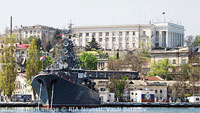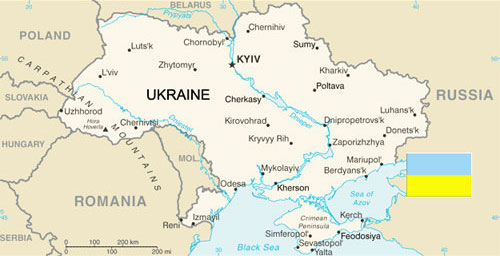Business New Europe: Spectre of revolution haunts Ukraine

(Business New Europe – bne.eu – Graham Stack in Kyiv – December 3, 2013) Ten years on from the Orange Revolution that rolled back a rigged election, Ukraine again appears in the throes of revolution, after mass protests in Kyiv against the government’s failure to sign a deal for closer ties with the EU and ensuing police violence led to the opposition seizing control of Kyiv city centre – and forcing a crucial no-confidence vote set for December 3. At the same time, there is a question mark hanging over the continued loyalty to President Viktor Yanukovych of one of his key backers oligarch Dmitro Firtash and his cronies.
Ukrainians awoke on the morning of December 2 to a fundamentally changed country one in which physical control over the access roads to the heart of power at the centre of the nation’s capital, the buildings of the presidential administration and government, had passed to the opposition following a huge protest rally the previous day.
Parliament was the only government institution still functioning but this only allowed the leaders of the opposition parties to successfully table a no-confidence vote in the government for the following day December 3.
Mass demonstration
The December 1 demonstration has already entered Ukrainian mythology, with the number of 1m participants firmly established in the opposition internet discourse and even mainstream media in Ukraine. City dwellers asked by bne for their impression of the protest December 2 repeatedly named the figure of 1m. In contrast, the interior minister has claimed only 40,000 attended the rally.
According to bne calculations, the demonstration occupied the whole of the main square and central street of Kreschatik, giving a total of 100,000 square metres (sqm). Crowd density could be estimated at an average of 4 per sqm at the crowd’s heart at the peak of the protest, falling to 3 per sqm further back in the crowd, judging by photographs, thus producing a total of 300,000-400,000, making the demonstrations indeed a return to the sort of numbers last seen during the Orange Revolution exactly ten years ago.
Kyiv is historically a stronghold for pro-Europe and pro-national forces that are furious at the government’s sudden backtracking over the EU Association Agreement with its provisions for a Deep and Comprehensive Free Trade Area (DCFTA), after having built up to the signing over a period of months. They are also horrified at the blatant corruption that has flourished under Yanukovych, marking a return to the worst excesses of the Kuchma era pre-2004, covered in depth by bne. “This band in power is literally stealing the future from our children. They have stolen everything else they can, and now all that is left for them to steal is our future,” Darya Cherniychuk, a 53-year-old doctor, told bne.
Police brutality
However, the protest of December 1 significantly exceeded that of one week earlier, immediately following Ukraine’s refusal to sign the Association Agreement because it hadn’t received a promise of financial support from the EU. What changed the situation utterly was the night of November 29-30, when riot police cleared the Maidan central square of a group of around 1,000 protesters, using clearly excessive force to do so. The scenes of violence including indiscriminate beating and kicking of surprised protestors were rapidly disseminated on the internet and, most significantly, by central TV channels.
And while the main mass protest on December 1 was peaceful, only hundreds of metres away violence erupted when a squad of around 100 masked men equipped with sticks, bricks, chains and gas and even a bulldozer attempted to storm the presidential administration, despite its being guarded by hundreds of interior ministry troops and riot police.
Controversy surrounds the events, revolving around the apparent involvement of agent provocateurs hired hands in the crowd instigating vandalism or violence, either to legitimate a planned police crackdown, or to discredit the government internationally by forcing such, depending on whom you ask.
bne earlier encountered a group of 15 masked “provocateurs” acting as a unit, who broke off from the main demonstration to smash windows and force entry into Kyiv city hall on Khreschatik. They refused to answer questions as to who they were and what organisation they belonged to. Crowd members seized and interrogated two of them and established that they were not from Kyiv, appeared to be Russian speaking and failed to display any ideological convictions. Later the opposition, however, occupied Kyiv city hall and made it their headquarters.
The later attack on the presidential administration similarly started from nothing, when a bulldozer suddenly appeared and with it a squad of men obviously equipped for violence. While the bulldozer stopped short of the police ranks, the masked attackers let loose with bricks and flailed chains and sticks, while peaceful demonstrators tried to hold them back.
The group was led by a notorious Ukrainian ultranationalist Dmitro Korchinskii, who made his name leading a Ukrainian unit against Russian forces in Chechnya in the 1990s, and has happily acknowledged his role in Sunday’s events. However, Korchinskii and his Bratsvo group are widely regarded as professional provocateurs ready to lend some violence to anyone prepared to pay, according to a critic of Ukraine’s nationalist movement, Nina Potarska. Leader of Svoboda, Ukraine’s leading nationalist party, Oleh Tiahnibok has disavowed any connection to the group.
Equally bizarre has been the behaviour of the highly trained riot police, in Ukraine called Berkut, starting November 29 night with the clearing of the Maidan, ostensibly in preparation for erecting the city’s Christmas tree. Berkut have displayed a level of indiscriminate violence cynics argue seems tailored for the media right up to targeting of local and foreign journalists themselves, which led to as many as 50 journalists being injured when covering the attempted storm of the presidential administration on December 1, according to media watchdog Telekritika. Furthermore, Berkut have happily kicked victims on the ground in full view of cameras, adding to the impression they are playing an equally scripted part as the mysterious provocateurs in the performance.
Firtash jumps ship?
But perhaps the most significant shift since last week is not the hundreds of thousands on the streets or even the violence, but the one taking place behind the cameras.
Ukraine’s largest and most influential TV station, Inter, traditionally utra-loyal to Yanukovych and his Party of Regions, has done a U-turn and is backing the protestors, playing repeat sequences of the police brutality in the run-up to the December 1 protests.
At the same time, Serhiy Liovochkin, the head of the presidential administration and a co-owner of Inter, offered his resignation on November 30, apparently in protest against the police violence. His wife had previously been visible on the Maidan lending support to the protestors. President Yanukovych however has refused to accept his resignation and Liovochkin formally remains in office.
Crucially, a group of five parliamentary deputies from the Party of Regions who are believed to be personally loyal to Liovochin have announced they are leaving the Party of Regions parliamentary group including Irina Bohoslovska, a Crimean deputy previously notorious for her servility both towards the party and to Russia, who has overnight turned into an outspoken opponent of Yanukovych and is calling for the government to resign.
The MPs all cite the “inexcusable use of violence” by the Yanukovych regime. The total number of MPs loyal to Liovochkin may number 20, and if the backbench revolt snowballs at the December 3 vote of no confidence it could bring down the government. Another 20 current Party of Regions MPs switched to the party in 2010 from the Bloc of Yulia Tymoshenko (BYuT) apparently after large sums of money changed hands, and may be ready to switch back for the same reason.
Inter majority shareholder and Liovochkin’s apparent political patron is Ukraine’s second richest man, gas and chemicals oligarch Dmitro Firtash. In December 2012, another top politician regarded as a client of Firtash, former deputy prime minister Valery Khoroshkovsky, resigned noisily from the government in protest at the growing influence of Yanukovych’s family and personal associates, and to preempt his likely firing from the government. Khoroshkovsky was at the time formally owner of Inter, and for a few days following his resignation the channel turned oppositional, until Firtash took over the reins directly and made peace with the government. But Khoroskovsky’s move of one year ago seems to anticipate Liovochkin’s move over the weekend, indicating the Firtash clan is again moving against the government and its increasing dominance by the friends of the youngest son of Viktor Yanukovych, Oleksandr.
Firtash himself has not made any public criticism of the government and kept his head down during the turbulence of the last week. But over the last year, the Yanukovych inner circle have moved in on Naftogaz, Ukraine’s largest company, regarded as a traditional source of plunder for elites. For the best part of a decade since 2003, Naftogaz has been the fiefdom of Firtash and his associates such as Khoroshkovsky, Lyovochin, and Deputy PM Yury Boiko. But since December 2012, virtually all ministerial and bureaucratic posts connected with Naftogaz have been occupied by confidantes of Oleksandr Yanukovch, with only Boiko and Naftogaz CEO Evhen Bakulin remaining from the old guard. Moreover, the government is believed to have been leaning on Firtash to pay more taxes.
Taken from this perspective, events in Kyiv may be starting to resemble not so much the Orange Revolution of ten years ago, but Moldova’s revolution of April 2009 where mass meetings against election falsification led to a sudden and still largely unexplained outbreak of violence by protestors, which in turn prompted the defection to the opposition of a key oligarch in the Moldovan case the country’s richest man, Vlad Plahotniuc who had been increasingly squeezed by then president Vladimir Voronin and Voronin’s son Oleg.
However, to ordinary people in the streets of Kyiv, this behind-the scenes maneuvering by oligarchs may be irrelevant. Moldova successfully signed an Association Agreement at the Vilnius summit on November 28, and is even set to receive a visa-free entry regime for Europe. As such, Moldova has become a role model for Ukraine to follow – and a potent symbol of Ukrainian’s European aspirations.

